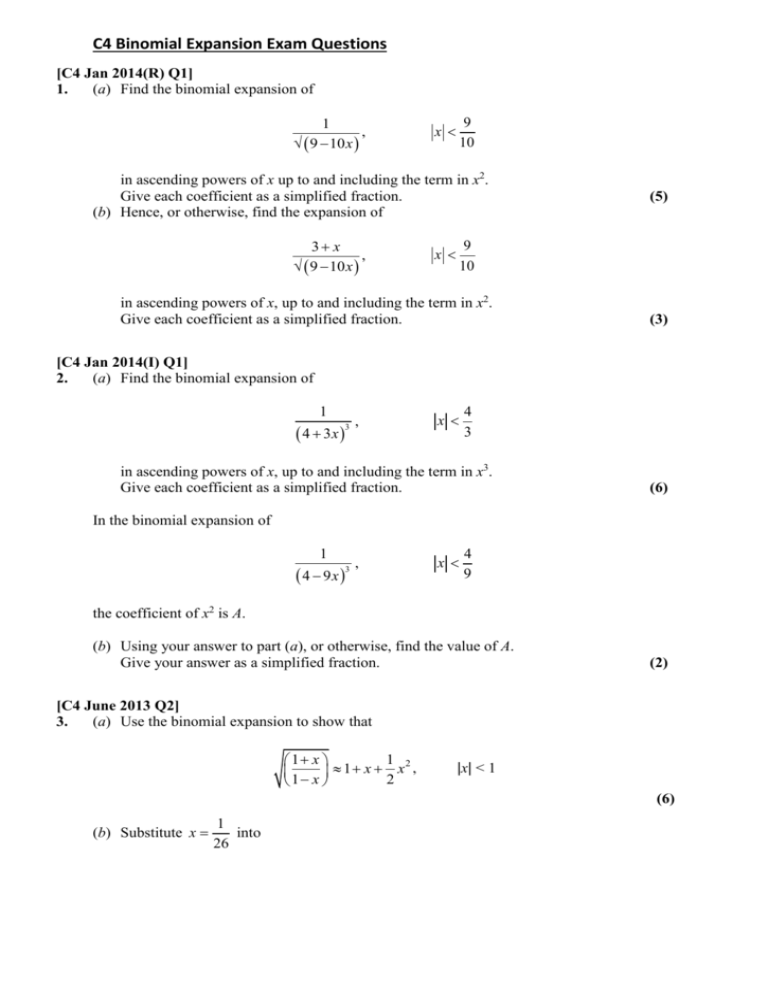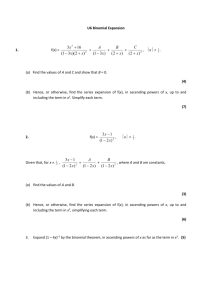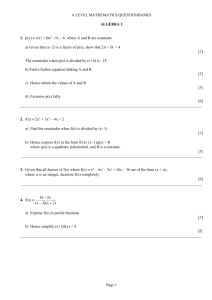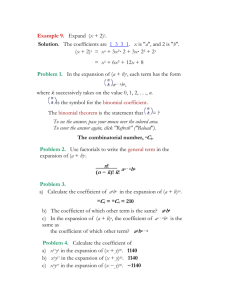C4 Chapter 3 - Binomial Expansion Exam Questions
advertisement

C4 Binomial Expansion Exam Questions [C4 Jan 2014(R) Q1] 1. (a) Find the binomial expansion of 1 , 9 10x 9 10 x in ascending powers of x up to and including the term in x2. Give each coefficient as a simplified fraction. (b) Hence, or otherwise, find the expansion of 3 x , 9 10 x (5) 9 10 x in ascending powers of x, up to and including the term in x2. Give each coefficient as a simplified fraction. (3) [C4 Jan 2014(I) Q1] 2. (a) Find the binomial expansion of 1 4 3x 3 , x 4 3 in ascending powers of x, up to and including the term in x3. Give each coefficient as a simplified fraction. (6) In the binomial expansion of 1 4 9x 3 , x 4 9 the coefficient of x2 is A. (b) Using your answer to part (a), or otherwise, find the value of A. Give your answer as a simplified fraction. (2) [C4 June 2013 Q2] 3. (a) Use the binomial expansion to show that 1 2 1 x 1 x x , 2 1 x |x| < 1 (6) (b) Substitute x 1 into 26 1 2 1 x 1 x x 2 1 x to obtain an approximation to √3. Give your answer in the form a where a and b are integers. b (3) [C4 June 2013(R) Q4] 4. (a) Find the binomial expansion of 3 (8 9 x) , |x| < 8 9 in ascending powers of x, up to and including the term in x3. Give each coefficient as a simplified fraction. (6) 3 (b) Use your expansion to estimate an approximate value for 7100 , giving your answer to 4 decimal places. State the value of x, which you use in your expansion, and show all your working. (3) [C4 Jan 2013 Q1] 5. Given f(x) = (2 + 3x)–3, |x| < 2 , 3 find the binomial expansion of f(x), in ascending powers of x, up to and including the term in x3. Give each coefficient as a simplified fraction. (5) [C4 June 2012 Q3] 6. f(x) = 6 , (9 4 x) x < 9 . 4 (a) Find the binomial expansion of f(x) in ascending powers of x, up to and including the term in x3. Give each coefficient in its simplest form. (6) Use your answer to part (a) to find the binomial expansion in ascending powers of x, up to and including the term in x3, of 6 , (9 4 x) 6 (c) h(x) = , (9 8 x) (b) g(x) = 9 , 4 9 x < . 8 x < (1) (2) [C4 Jan 2012 Q3] 7. (a) Expand 1 , (2 5 x) 2 x < 2 , 5 in ascending powers of x, up to and including the term in x2, giving each term as a simplified fraction. (5) Given that the binomial expansion of 2 kx 2 , x < , is 2 5 (2 5 x) 1 7 + x + Ax2 + . . ., 2 4 (b) find the value of the constant k, (c) find the value of the constant A. (2) (2) [C4 June 2011 Q2] 8. f (x) = 1 , (9 4 x 2 ) x < 3 . 2 Find the first three non-zero terms of the binomial expansion of f(x) in ascending powers of x. Give each coefficient as a simplified fraction. (6) [C4 Jan 2011 Q5] 9. (a) Use the binomial theorem to expand (2 – 3x)–2, x < 2 , 3 in ascending powers of x, up to and including the term in x3. Give each coefficient as a simplified fraction. (5) f(x) = a bx 2 , x < , where a and b are constants. 2 3 (2 3x) In the binomial expansion of f(x), in ascending powers of x, the coefficient of x is 0 and the 9 coefficient of x2 is . 16 Find (b) the value of a and the value of b, (c) the coefficient of x3 , giving your answer as a simplified fraction. (5) (3) [C4 June 2010 Q5] B C 2 x 2 5 x 10 A+ + . x 1 x2 ( x 1)( x 2) 10. (a) Find the values of the constants A, B and C. (4) 2 2 x 5 x 10 (b) Hence, or otherwise, expand in ascending powers of x, as far as the term in ( x 1)( x 2) x2. Give each coefficient as a simplified fraction. (7) [C4 Jan 2010 Q1] 11. (a) Find the binomial expansion of (1 – 8x), x < 1 , 8 in ascending powers of x up to and including the term in x3, simplifying each term. (6) 1 23 (b) Show that, when x = , the exact value of (1 – 8x) is . (2) 100 5 1 (c) Substitute x = into the binomial expansion in part (a) and hence obtain an 100 approximation to 23. Give your answer to 5 decimal places. (3) [C4 June 2009 Q1] 12. f(x) = 1 , x < 4. (4 x) Find the binomial expansion of f (x) in ascending powers of x, up to and including the term in x3. Give each coefficient as a simplified fraction. (6) [C4 Jan 2009 Q3] 13. f(x) = 2 27 x 2 32 x 16 , x < . 2 3 (3x 2) (1 x) Given that f(x) can be expressed in the form f(x) = B A C + + , 2 (3x 2) (3x 2) (1 x) (a) find the values of B and C and show that A = 0. (4) (b) Hence, or otherwise, find the series expansion of f(x), in ascending powers of x, up to and including the term in x2. Simplify each term. (6) (c) Find the percentage error made in using the series expansion in part (b) to estimate the value of f(0.2). Give your answer to 2 significant figures. (4) [C4 June 2008 Q5] 14. 1 , where x < (4 3x) in x2. Simplify each term. (a) Expand 4 3 , in ascending powers of x up to and including the term (5) x8 (b) Hence, or otherwise, find the first 3 terms in the expansion of as a series in (4 3x) ascending powers of x. (4) [C4 Jan 2008 Q2] 15. (a) Use the binomial theorem to expand 1 3 (8 3x) , x < 83 , in ascending powers of x, up to and including the term in x3, giving each term as a simplified fraction. (5) (b) Use your expansion, with a suitable value of x, to obtain an approximation to 3(7.7). Give your answer to 7 decimal places. [C4 June 2007 Q1] 16. (2) f(x) = (3 + 2x)–3, x < 3 2 . Find the binomial expansion of f(x), in ascending powers of x, as far as the term in x3. Give each coefficient as a simplified fraction. [C4 Jan 2007 Q1] 17. (5) f(x) = (2 – 5x)–2, x < 2 5 . Find the binomial expansion of f(x), in ascending powers of x, as far as the term in x3, giving each coefficient as a simplified fraction. (5) [C4 June 2006 Q2] 18. f(x) = Given that, for x 1 2 , 3x 1 , (1 2 x ) 2 x < 1 2 . 3x 1 B A = + , where A and B are constants, 2 (1 2 x ) (1 2 x) (1 2 x ) 2 (a) find the values of A and B. (3) (b) Hence, or otherwise, find the series expansion of f(x), in ascending powers of x, up to and including the term in x3, simplifying each term. (6) [C4 Jan 2006 Q5] 19. f(x) = C 3x 2 16 A B = + + , x < 2 (2 x) 2 (1 3 x) (2 x) (1 3x)( 2 x) 1 3 . (a) Find the values of A and C and show that B = 0. (4) (b) Hence, or otherwise, find the series expansion of f(x), in ascending powers of x, up to and including the term in x3. Simplify each term. (7) [C4 June 2005 Q1] 20. Use the binomial theorem to expand (4 – 9x), x < 4 , 9 in ascending powers of x, up to and including the term in x3, simplifying each term. (5) Solutions Question 1 Question 2 Question 3 Question 4 Question 5 Question 6 Question 7 Question 8 Question 9 Question 10 Question 11 Question 12 Question 13 Question 14 Question 15 Question 16 Question 17 Question 18 Question 19 Question 20









